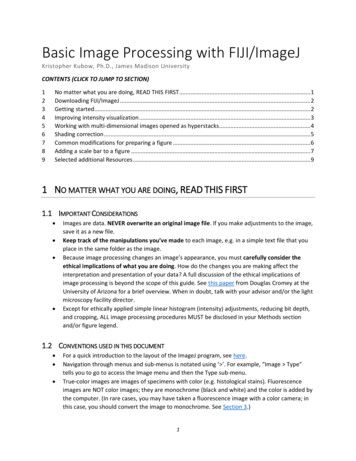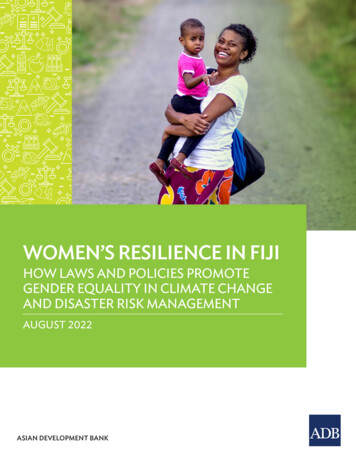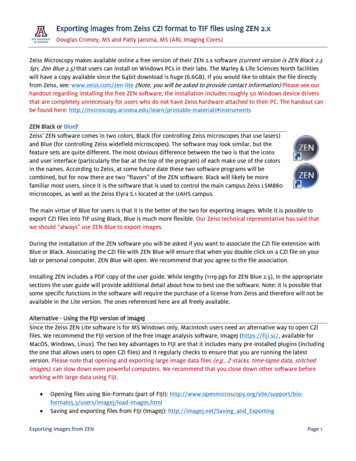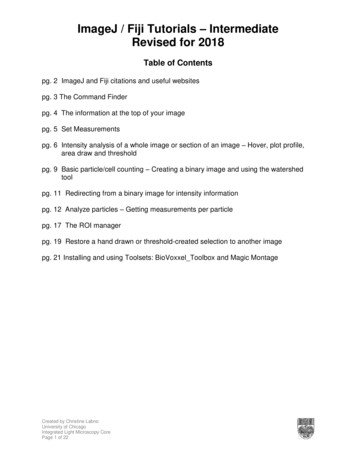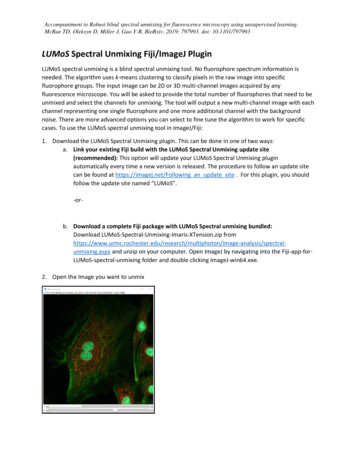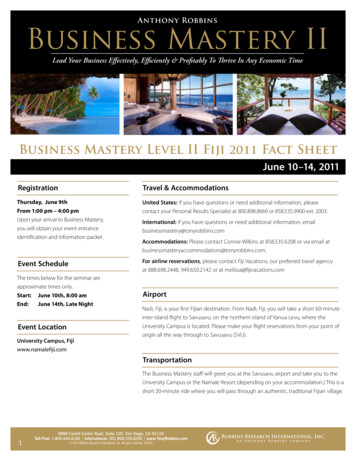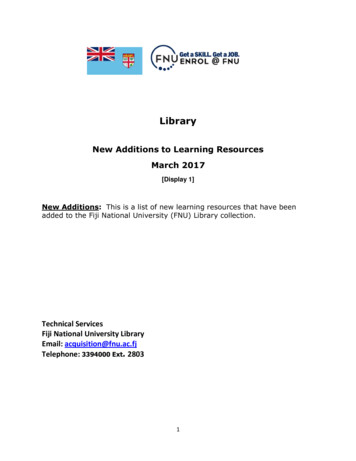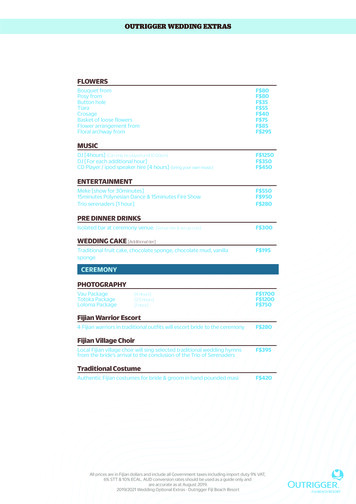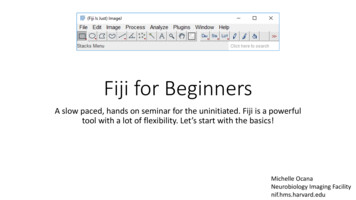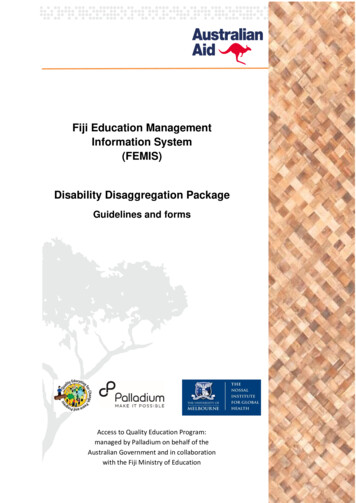
Transcription
Fiji Education ManagementInformation System(FEMIS)Disability Disaggregation PackageGuidelines and formsAccess to Quality Education Program:managed by Palladium on behalf of theAustralian Government and in collaborationwith the Fiji Ministry of Education
FEMIS DISABILITY DISAGGREGATION PACKAGE – GUIDELINES AND FORMSContentsAcronyms . 2FEMIS Disability Disaggregation Package – Overview. 31 Section 1 – Student Learning Profile . 51.1 Why should we complete the Student Learning Profile? . 51.2 Which students need to have a form completed? . 51.3 Who should complete the form? . 61.4 When should the form be completed? . 61.5 How do we choose which level of difficulty the student has in Question 3? . 81.6 Does this mean the child has a disability? . 81.7 Changing information on the child’s SLP once it has been submitted online . 81.8 What is the difference between Learning (General) and Learning (Specific) in Question 3? . 141.9 How to complete Question 6 – Clinical, Diagnostic, Treatment and Referral Information . 141.10 Referring some children for medical or health assessments or services . 141.11 What if the medical/health referral leads to an assessment with differing results from theteacher/parent rating on the Student Learning Profile? . 161.12 Does this information link with the “screening tools” in the appendices of the Toolkit forDisability-Inclusive Education? . 161.13 Additional guidance for select questions in the Student Learning Profile . 162 Section 2 – School accessibility and inclusion assessment . 172.1 Accessibility audit . 172.2 Special materials or equipment. 172.3 Recording other school efforts to include children with disabilities . 173 Section 3 – Data entry . 183.1 Who can enter the data onto FEMIS online? . 183.2 What if our school does not have access to the internet? . 184 Section 4 – Data approval and verification processes . 184.1 Student disability data . 184.2 Generating a list of students for approval or verification . 194.3 Verification and Support Visits . 195 Section 5 – Qualifications and professional development of school staff . 21Appendix 1: Glossary of terms – including assistive devices and materials. 22Appendix 2: Student Learning Profile form . 23Appendix 3: School Accessibility and Inclusion Assessment formAppendix 4: Notice to teachers at the start of each yearFigures and tablesFigure 1:Steps in collecting, entering and verifying functioning and disability data . 7Figure 2:Verification Officer - steps in verifying disability data . 20Table 1:Student Learning Profile guidance . 10Table 2:Referrals required for children identified as having functional difficultieson the Student Learning Profile . 155PAGE 1
FEMIS DISABILITY DISAGGREGATION PACKAGE – GUIDELINES AND oESEOSLDSLPSMCUNUSPAustralia Pacific Technical CollegeDistrict Education OfficerEarly Childhood EducationFiji Education Management Information SystemFiji Education Staffing AppointmentsFiji National Council for Disabled PersonsFiji National UniversityInclusive EducationIndividual Education PlanLiteracy and Numeracy AssessmentMinistry of EducationSenior Education OfficerSpecific Learning DisabilityStudent Learning ProfileSchool Management CommitteeUnited NationsUniversity of the South PacificPAGE 2
FEMIS DISABILITY DISAGGREGATION PACKAGE – GUIDELINES AND FORMSFEMIS Disability Disaggregation Package – OverviewThe Fiji Education Management Information System (FEMIS) Disability Disaggregation Packageprovides primary and secondary schools in Fiji with a standardised means of recording and analysinginformation in FEMIS related to: disability in children (including type and severity of disability)accessibility of school infrastructure and transportqualifications and training of school staff in relation to disability-inclusive education.This Package is the most recent addition to the Toolkit for Disability-Inclusive Education, which allschools in Fiji received in 2015. Along with other resources in the Toolkit, this Disaggregation Packageis available to download from the Ministry of Education’s website under School Resources, Special &Inclusive Education Resources.The Package is divided into five sections:1)Student Learning Profile – identifying children with functional difficulties and those atrisk of disabilityThis section includes information on filling out the Student Learning Profile form which captures:a. Information to identify disability type and severity,b. Information to identify learning support needs (including assistive devices such aswheelchairs, hearing aids, etc; reasonable accommodations such as additional timeor a note-taker during assessments), andc. Information on clinical diagnosis, treatment and referral services.Information from the Student Learning Profile (SLP) form is the basis of the data entered into FEMIS.This section includes the SLP Guidance matrix (Table 1), which provides information to ensure accuratecompletion of the form. The SLP form is included as Appendix 2.Where teachers identify children with functional difficulties, they are referred to the DisabilityInclusive Education Handbook for Teachers, which is part of the Toolkit and is also available on theMinistry’s website. It is of enormous value in providing information for teachers to improve the waythey make their classrooms more inclusive for children with disabilities. You are strongly encouragedto refer to the relevant chapters in the Handbook once you have identified functional difficulties in anyof your students.2)School accessibility and inclusion assessmentThis section provides information related to the School Accessibility and Inclusion Form, whichcaptures information on the accessibility of school infrastructure and transport as well as activitiesundertaken and/or supports provided by schools to improve inclusion.PAGE 3
FEMIS DISABILITY DISAGGREGATION PACKAGE – GUIDELINES AND FORMS3)Data entry processesThis section outlines how schools enter the data from the Student Learning Profile into FEMIS.4)Data verification processesThere are several layers of approval and verification required to confirm a child with disability has beenidentified. These include verification by Head Teachers, District Education Office staff, and the Ministryof Education, and are described in section 4.5)Qualifications and professional development of school staffThis section provides a standardised list of special/inclusive education qualifications and professionaldevelopment which the Ministry of Education needs to record about staff on the Fiji Education StaffAppointment (FESA) database to enable monitoring and evaluation of human resource developmentin relation to disability-inclusive education.PAGE 4
FEMIS DISABILITY DISAGGREGATION PACKAGE – GUIDELINES AND FORMS1 Section 1 – Student Learning ProfileIdentifying children with functional difficulties and those at risk of disabilityThe Student Learning Profile form is in Appendix 2. It is a six-page document which should be printedand used to assess all children who have any degree of difficulty functioning in the areas outlinedbelow in section 1.2. The form is also available online on the student page in FEMIS in the tab“Function/Disability”.1.1Why should we complete the Student Learning Profile?Fiji is serious about access to quality and inclusive education for all children with disability. The MoEhas a Policy on Special and Inclusive Education and is actively implementing this policy. In addition, theGovernment of Fiji has announced the imminent ratification of the UN Convention on the Rights ofPersons with Disabilities, which clearly outlines the need for countries to move as rapidly as possibletowards implementation of inclusive education. Aligned to this is the Fiji Parliamentary Bill No.12 –Rights of Persons with Disabilities.By collecting more detailed information on students’ functioning and learning support needs, the MoEis able to plan resourcing to meet those needs and evaluate the effectiveness of efforts towardsinclusive education. For some children, their learning support needs will indicate eligibility for supportsincluding a disability inclusion grant for the school and/or increased staffing ratio per child. As thegovernment increases its efforts to resource its Policy on Special and Inclusive Education, it needs datato monitor the effectiveness of those resources.When interpreting class LANA scores or other exam scores, it can be useful for the MoE to crossreference with the functioning and disability data of students in the class. Schools are encouraged toenroll children with disabilities, and those children are encouraged to undertake assessments alongwith all other children (with relevant ‘reasonable accommodation’ or supports). However someteachers or schools are worried that enrolling children with disabilities may lower their class averagesfor test results. This perception has been a barrier to inclusive education in many countries. Byproviding functioning and disability data in FEMIS, this enables the MoE to cross-reference LANA orexam results with functioning data to make more sense of class exam averages in the context ofimplementing the Policy on Special and Inclusive Education.1.2Which students need to have a form completed?If you are in a regular school, many children in your class will not need the form to be completed. Theform should be completed for: all children with difficulties with any of the following areas: seeing, hearing, moving (grossand fine motor), speaking, learning, behavior/socialization, or emotions; andall children who consistently perform very poorly in assessments and class activities (this canassist to identify children at risk of learning disabilities).The exception is Special Schools, which must complete the form for every student in the school.PAGE 5
FEMIS DISABILITY DISAGGREGATION PACKAGE – GUIDELINES AND FORMS1.3Who should complete the form?The best results are achieved when teachers work together with the parents/guardian to complete theform. This enables discussion about: difficulties the child may have, history of clinical assessments andtreatment where relevant, and options for supporting the child and managing difficulties, enabling thefullest potential for learning outcomes. In cases where it is impossible to meet with theparent/guardian, it is acceptable for teachers to complete the Student Learning Profile formindependently.In addition, if it is possible to include other staff who know the child well, this improves the resultseven further. For example, a teacher aide, the child’s teacher from the previous year, and the schoolInclusion Coordinator or Disability Focal Person (if applicable) would all add value to the meeting.If a child is being transferred from a special school to a mainstream school, the parent and mainstreamteacher should complete the form together with the teacher from the referring special school.1.4When should the form be completed?On the whole, the Student Learning Profile should be entered on the child’s FEMIS file by the end ofTerm 1 of each school year. This enables planning and budgeting at the Ministry level.However, it is recognized that this is not always possible. The form should be completed as soon as itis identified that the child has any functioning difficulties. For some children, this will be aroundenrolment because it is clear at an early stage that the child may have particular difficulties and supportneeds.Some children may have functional difficulties that are not immediately obvious to the teacher. At anystage in the school year, it is appropriate to complete the form, so do this as soon as difficulties areidentified. It is appropriate to submit new information when this becomes known.Data from the form are used to complete the Function/Disability page in FEMIS within the student’sindividual page. As soon as the paper-based form has been completed, it should be entered onto FEMISby the teacher or provided to the person responsible at the school for entering information into FEMIS(see section 3). After data is entered into FEMIS, the paper version of the Student Learning Profile formshould be kept in the student’s confidential school file.Students with a completed Student Learning Profile from the previous year(s) still require a new formto be completed for them by the end of Term 1 in each new school year. This enables functionalchanges to be recorded, and is a chance to update other information that may have changed. Part 2of the form (clinical, diagnostic, treatment information) will remain in place from previous data entry.These details should be checked for updates required, especially if there have been referrals that havebeen actioned, services received, new diagnoses, etc.PAGE 6
FEMIS DISABILITY DISAGGREGATION PACKAGE – GUIDELINES AND FORMSFigure 1: Steps in collecting, entering and verifying functioning and disability dataIdentifystudentsSLP meetingData entry Head Teacher alerts all teachers to the need to complete Student Learning Profiles (SLP)(see Appendix 4 for letter template to inform teachers at the start of each year) Teacher identifies which students need a SLP (see section 1.2) Teacher organises meeting to complete the Student Learning Profile (SLP) (see section 1.3) The SLP is completed; clinical or medical certificates or reports should be photocopied andkept with the SLP Any referrals required should be listed, responsible person named, and followed up Information from the SLP is entered into FEMIS (see Section 3). The paper form should be filed in the student's confidential school file Head Teacher approves the data entered on FEMIS and ticks the approval box on thestudent's online SLP (see Section 4)ApprovalVerificationMoEapprovalAmendmentsto SLP made District Education Office (EO or Divisional Counsellor) visits the school to undertakeverification of only the children at risk of disability (see Section 4) and to review the SchoolAccessibility & Inclusion Form (see Section 2) EO or Divisional Counsellor ticks the approval box on the student's online SLP SEO (Special & Inclusive Education) reviews information on children verified by the DEOand considers eligibility for resourcing. Information on the SLP is likely to change over time. Changes in student functioningshould be recorded, as well as results of new clinical assessments and services. (seesection 1.7)PAGE 7
FEMIS DISABILITY DISAGGREGATION PACKAGE – GUIDELINES AND FORMS1.5How do we choose which level of difficulty the student has in Question 3?Question 3 on the SLP is very important for the MoE to determine the student’s level of function. Itrequires consideration of the level of difficulty a student has in various actions such as seeing, hearing,walking, speaking, etc. Most people easily identify students with “No difficulty” in a functional area, orthose who “Cannot do at all”. For example a student who is completely blind would have the response“Cannot do at all” for the question on Seeing. However, it can be challenging to choose between “Alittle difficulty” and “A lot of difficulty”. Table 1 provides guidance on choosing categories that matchyour student’s function. It is important that teachers refer to Table 1 regularly when they are beginningto use the form. Once teachers are more experienced, selection of categories will be clear and simple.1.6Does this mean the child has a disability?Completing the form does not automatically mean the child has a disability. The system will identifychildren “at risk of disability” and for whom additional learning supports and/or referrals to healthservices are required. The system does not generate a diagnosis of disability; teachers and parents aremerely recording their observations of the child’s level of function in different activities. There is noharm in completing a form for a child if you are uncertain if it is required.The form will help you to identify learning support needs of any of your students and can be a helpfulprocess for reasons other than identifying disability. It can also help identify children who may havetemporary difficulties which may benefit from treatment. For example, many children in Fiji have beenidentified as having difficulty hearing and have been treated for ear infections, impacted wax or foreignbodies lodged in the ear – and the treatment has resulted in a return to completely normal levels ofhearing! Similarly, children with difficulties seeing may benefit from something as simple as glasses(spectacles). If you suspect any difficulties in your students, please go ahead and complete the form.1.7Changing information on the child’s SLP once it has been submitted onlineThere are several reasons you may need to amend the information in the SLP that you submittedonline: (i) you made a mistake; (ii) you referred the child for an assessment and it turns out that yourinitial belief about their difficulty was not correct – e.g. sometimes teachers and parents assume thatthe child has difficulty learning, but after a vision or hearing assessment they realise it is a sensory nota learning difficulty; once the child has glasses or hearing aids they may have no difficulty learning; and(iii) the verification visit from the District Education Office showed that there were errors on the SLP.On the paper SLP form that is stored in the student’s personal school file, please amend the existinginformation using a different coloured pen to indicate the changes, including dating the changes. Toupdate the information from pages 1-5 of the form online, log in to FEMIS, go to the student’s classlist, go to the student’s file, click on the Function/Disability tab, and click on the saved SLP form – Part1. Enter in the correct information. In the comment section at the bottom of Q3 on the form, pleaseinclude any information that could help explain why the form has been changed.If new clinical or service information becomes available (from Part 2 on page 6 of the form), this canbe updated on the section on the student’s Function/Disability tab - Student Learning Profile - part 2(Clinical, Diagnostic, Treatment and Referral Information). Please click on “Add New Diagnosis” forinformation related to new diagnoses, or click on an existing diagnosis if new service information needsto be recorded online related to that diagnosis.PAGE 8
FEMIS DISABILITY DISAGGREGATION PACKAGE – GUIDELINES AND FORMSTable 1: Student Learning Profile guidanceThis table provides descriptors to assist in selecting which level of difficulty to choose for each area in Question 3 on the Student Learning Profile form.Difficulty:3aSeeingGeneral definitionNo difficultyThis is about the ability of theeyes to see, for example, peoples’faces, objects, writing or pictureson the blackboard or in books.Child is able to see theboard, books, objects, facialexpressions, etc. to thesame extent as most otherchildren of that age.It is NOT about the brain’s abilityto understand what is seen.HearingHearing sounds like peoples’voices or music.Note: this refers to child’s ability tohear, even when using hearingaids, if the child uses hearing aids.3cGross motoractionsWalking or climbing stairsNote: if the child has a mobility aidsuch as wheelchair, crutches orwalker, or receives assistance formoving, this question asks aboutthe child’s ability to walk or climbstairs even when using themobility aid or receivingassistance.Child has difficulty seeing,but this can be overcome,for example, when the childsits closer to the board orholds the book closer to theeyes.Or, glasses or contactlenses overcome thedifficulty.Note: this refers to child’s abilityto see, even when wearingspectacles / glasses (or contactlenses) if the child currently usesthem.3bA little difficultyA lot of difficultyCannot do at allThe child’s vision cannot becorrected to normal vision evenby wearing glasses, but the childhas some vision.A child is considered legally blindwhen s/he cannot see at 6 metreswhat a child with normal vision cansee at 60 metres, or if her field ofvision is less than 20 in diameter(a person with normal vision cansee 180 ).Or, glasses or contact lensesmay overcome the difficulty butthe child does not have accessto glasses.Child is able to hear to thesame extent as otherchildren of that age.Child may have difficultyhearing soft or distantspeech. They may also havedifficulty hearing normalconversation where there isa lot of background noise.Child needs to wear hearing aidsto understand normal speech.For some children, even ifwearing hearing aids, they willnot understand normal speech.Without hearing aids, the childwill need to rely on lip reading orsign language.Children with profound hearing losswill always have difficultyunderstanding conversationalspeech and would not detect eventhe loudest shout without hearingaids. Many children with profoundhearing loss will need to use signlanguage.Can walk independentlyover 500 metres, eitherindoors or outdoors (withcrutches or walker ifneeded); can climb stairswithout assistance.Can walk independently(with crutches or walker ifneeded) 100 metres eitherindoors or outdoors; canclimb stairs using a railing orwith minimal support.Walking is limited even withcrutches or walker; requiressupport to climb stairs, or cannotclimb stairs.Has difficulty with voluntary controlof movement. Cannot sit, stand orwalk independently even withmobility aids.Or, uses a wheelchairindependently. May be able topropel independently (push thewheels herself) in a wheelchair.Cannot propel (push the wheelsherself) in a wheelchair.Or, has a little difficultymoving between sitting andstanding.Or, has a lot of difficulty movingbetween sitting and standing.PAGE 9
FEMIS DISABILITY DISAGGREGATION PACKAGE – GUIDELINES AND FORMSDifficulty:General definitionNo difficultyA little difficultyA lot of difficultyCannot do at all3dFine motoractionsUsing hands and fingers fordetailed tasks, such as writing,drawing, controlling pencil, pickingup coins or other small object, orfastening clothes.No difficulty, or at leastaverage compared tochildren of the same age.A little difficulty grasping,holding or using smallobjects with hands andfingers but can manageindependently.A lot of difficulty grasping,picking up, holding or usingsmall objects with hands andfingers; for example, holding andusing pen, spoon, doing buttonsor zipper. May need assistanceor a special aid to help withgripping objects.Child is basically unable to usehands and fingers to do fine motoractions. Assistance or a special aidfor gripping objects is required toassist with eating and other finemotor tasks.3eSpeakingBeing understood when speakingin the language that is mostcustomary (preferred) for the child.Able to speak and beunderstood clearly.Mild difficulty speaking orbeing understood whilespeaking; can include mildstuttering (interruption of theflow of speech, prolongationof sounds or words).Speaks only a little. Or, is verydifficult to understand.Or, mostly avoids speaking.Or, seems to struggle to getwords out. Or, uses only simplesentences (less than 4 words).Or, mixes up the order of wordsin a sentence. Or, has a verylimited vocabulary compared toother children. Or, hassignificant stuttering.Does not speak at all (mute).Not able to understand what istaught.3fLearning(general)Includes school tasks, such asliteracy and numeracy, as well asmore general intellectual functions,such as remembering, andlearning everyday tasks includingthose at home. Important tocompare to children of the sameage who do not have difficulties.Able to learn both schoolskills and regular skillsrequired at home, at thesame level (or above) asother children the same age.Needs some assistance butcan work independently.Has a lot of difficulty withlearning academic skills andconcepts; or, with learningto do practical tasks such asunpacking schoolbag, puttingbooks and pencils in desk,doing jobs or duties, homeresponsibilities, including selfcare (toileting, dressing, eating).3gLearning(specific)Compared with children of thesame age, child has specificdifficulties in areas within literacyor numeracy (e.g. dyslexia,dyscalculia). Specific learningdisabilities such as dyslexia impacta lot on only some aspects oflearning. These students oftenlearn other skills very well.No difficulty with literacy ornumeracy activities.Mild difficulties with literacyor numeracy activities. Childappears to be improving inthese areas.Child is at risk of, or has beendiagnosed with, dyslexia (oranother Specific LearningDisability). Teachers are referredto the Dyslexia IndicatorsAssessment Tool for Fiji, and tothe Handbook within the Toolkitfor Disability InclusiveEducation.If the child uses sign language butdoes not speak, this is the correctcategory to select for question 3e.Child shows clear abilities insome areas; alongsideweaknesses in areas that showas: poor handwriting with manyPAGE 10
FEMIS DISABILITY DISAGGREGATION PACKAGE – GUIDELINES AND FORMSerrors and words tried severaltimes; spelling a word differentways in one piece of writing;no expression in reading;poor comprehension; fails torecognise familiar words; slowspeed of processing information;poor concentration; exhaustionfrom extra effort required toconcentrate; difficulty followinginstructions.3hBehaviour/Attention /SocialisationDifficulty controlling his/her ownbehaviour; and/or focusing andconcentrating; and/or acceptingchanges to routine.Behaves and socialisesnormally.Difficulty making eye contactwith the teacher.Able to follow instructions;responds appropriately inconversation.Or, needs a little more timeto adjust when routineschange.Compared to children thesame age, may displaymildly higher levels ofaggressive, destructive orself-injurious behaviour,anger, inability to handlefrustration, being disruptiveor oppositional (hostile andunco-operative).Requires adult assistance withsome behaviour and socialactivities, but can do somethings independently.A lot of difficulties withfriendships and interpersonalrelationships; difficulty stayingon a task; overly dependent onroutines;Short attention span; impulsiveor hyperactive; poor attention todetail; difficulty organising tasksor following instructions;frequently loses books,homework, toys, other items;excessive talking, fidgeting orinability to remain seated inappropriate situations.Needs frequent adult assistance.May display actions such as:repetitive behaviours such asrocking, waving or flapping;intensely focused on inappropriateitems; obsesses over particulartopics of conversation; unable tomaintain friendships; becomesfixated on certain sensoryexperiences, e.g. lights or textures.Compared to children the sameage, may display much higherlevels of aggressive, destructive orself-injurious behaviour, anger,inability to handle frustration, beingdisruptive or oppositional (hostileand unco-operative).Compared to children the sameage, may display moderatelyhigher levels of aggressive,destructive or self-injuriousbehaviour, anger, inability tohandle frustration, beingdisruptive or oppositional(hostile and unco-operative).PAGE 11
FEMIS DISABILITY DISAGGREGATION PACKAGE – GUIDELINES AND FORMS3iEmotionsHow often does the child seem:Very sad and depressed, and/orvery worried and anxiousNever or a few times/ yearMonthlyWeeklyChild seldom (rarely) seemsvery sad, depressed and/orfeels very worried andanxious. Sometimes, but notvery often.Child seems very sad,depressed and/or feels veryworried and anxious aboutonce a month. Slightly morethan average children of thesame age.Child seems very sad,depressed and/or feels veryworried and anxious about oncea week.DailyChild seems very sad, depressedand/or feels very worried andanxious every day.Symptoms of depression may include: persistent sad or irritable mood(poss
2) School accessibility and inclusion assessment This section provides information related to the School Accessibility and Inclusion Form, which captures information on the accessibility of school infrastructure and transport as well as activities undertaken and/or supports provided by schools to improve inclusion.

